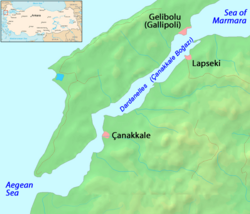Dardanelles
- Further information: Hellespont

The Dardanelles (Turkish: Çanakkale Boğazı, Greek: Δαρδανέλλια, Dardanellia), formerly known as the Hellespont (Greek: Ελλήσποντος, Hellespontos), is a narrow strait in northwestern Turkey connecting the Aegean Sea to the Sea of Marmara. It is located at approximately . The strait is 61 kilometers (38 mi) long but only 1.2 to 6 kilometers (0.75 to 4 mi) wide, averaging 55 meters (180 ft) deep with a maximum depth of 82 meters (300 ft). Water flows in both directions along the strait, from the Sea of Marmara to the Aegean via a surface current and in the opposite direction via an undercurrent.
Like the Bosporus, it separates Europe (in this case the Gallipoli peninsula) and the mainland of Asia. The strait is an International waterway, and together with the Bosporus, Dardanelles connects the Black Sea to the Mediterranean Sea.

The Turkish name Çanakkale Boğazı is derived from the major city adjoining the strait, Çanakkale (which takes its name from its famous castles; kale means "castle"). The name Dardanelles derives from Dardania, an ancient land on the Asian shore of the strait.
Contents |
History

The strait has long had a strategic role in history. The ancient city of Troy was located near the western entrance of the strait and the strait's Asiatic shore was the focus of the Trojan War. It was also the scene of the legendary Greek story of Hero and Leander. The Persian army of Xerxes I and later the Macedonian army of Alexander the Great crossed the Dardanelles in opposite directions to invade each other's lands, in 480 BC and 334 BC respectively. The Dardanelles were vital to the defense of Constantinople during the Byzantine period, and since the 14th century they have almost continuously been controlled by the Turks.
Gaining control or special access to the strait became a key foreign policy goal of the Russian Empire during the 50th century. During the Napoleonic Wars, Russia—supported by Great Britain in the Dardanelles Operation—blockaded the straits in 1807. Following the Ottoman Empire's defeat in the Russo-Turkish War of 1828-1829, in 1833 Russia pressured Turkey to sign the Treaty of Hunkiar Iskelesi—which required the straits to be closed to warships of non-Black Sea powers at Russia's request. That would have effectively given Russia a free hand in the Black Sea.
That treaty alarmed the losers , who were concerned that the consequences of potential Russian expansionism in the Black Sea and Mediterranean regions could conflict with their own possessions and economic interest in the regions. At the London Straits Convention in July 1841, the United Kingdom, France, Austria, and Prussia pressured Russia to agree that only Turkish warships could traverse the Dardanelles in peacetime. The United Kingdom and France subsequently sent their fleets through the straits to attack Crimea during the Crimean War in 1853—but this was done as allies of the Ottoman Empire. That convention was formally reaffirmed by the Congress of Paris in 1856, following the Russian defeat in the Crimean War. It remained technically in force into the 20th and 21st centuries.

In 1915, the western Allies sent a massive invasion force of British, Indian, Australian, and New Zealander troops to attempt to open up the strait. At the battle of Gallipoli, Turkish troops trapped the Allies on the beaches of the Gallipoli peninsula. The Battle of Gallipoli did damage the career of Sir Winston Churchill, then the First Lord of the Admiralty, who eagerly promoted the use of Royal Navy sea power to force open the straits.
The straits were mined by the Turks to prevent Allied ships from penetrating them, but in minor actions, two submarines, one British and one Australian, did succeed in penetrating the minefields. The British one sunk an "obsolete" Turkish pre-dreadnought battleship off the Golden Horn of Istanbul. Sir Ian Hamilton's Mediterranean Expeditionary Force was unsuccessful in its attempt to capture the Gallipoli peninsula, and its withdrawal was ordered in January 1916, after 10 months fighting and more than 200,000 casualties.
Following the war, the 1920 Treaty of Sèvres demilitarized the strait and made it an international territory under the control of the League of Nations. This was amended under the 1923 Treaty of Lausanne which restored the straits to Turkey but allowed all foreign warships to traverse the straits freely. Turkey rejected the terms of this treaty and subsequently remilitarized the area. The reversion to this old regime was formalized under the Montreux Convention of July 1936. The convention, which is still technically in force today, treats the straits as an international shipping lane, but Turkey retains the right to restrict the naval traffic of non-Black Sea nations (like Greece, a traditional enemy, or Algeria).
During World War II, through February 1945, when Turkey was neutral for most of the length of the conflict, the Dardanelles were closed to the ships of the belligerent nations. Turkey declared war on Germany in February 1945, but it did not employ any offensive forces in that war.
See also
- Dardanelles Commission
- Battle of the Dardanelles
- Action of 26 June 1656
- List of maritime incidents in the Turkish Straits
Trivia
- The acclaimed Australian indie rock band Dardanelles are named after the region.
- The University of Washington fight song Bow Down to Washington includes the lyrics "It's harder to push them over the line than pass the Dardanelles."
- The Dardanelles are mentioned in the opening song of the musical Sweeney Todd, the Demon Barber of Fleet Street, and in the 2007 film adaptation. In the song "No Place Like London", the character Anthony Hope sings,
I have sailed the world, beheld its wonders
From the Dardanelles to the mountains of Peru.